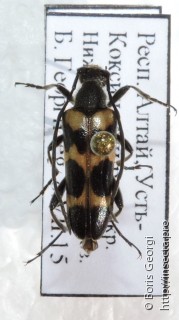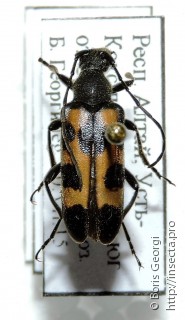Judolia dentatofasciata Mannerheim, 1852

Taxonomy
class Insecta → subclass Pterygota → infraclass Neoptera → superorder Holometabola → order Coleoptera → suborder Polyphaga → infraorder Cucujiformia → superfamily Chrysomeloidea → family Cerambycidae → subfamily Lepturinae → tribe Lepturini → genus Judolia → species Judolia dentatofasciata
Species name(s)
Judolia dentatofasciata Mannerheim, 1852 = Grammoptera parallelopipeda Motschulsky, 1860 = Leptura shirarakensis Matsumura, 1911 = Judolia parallelopipeda (Motschulsky, 1860). [187, 267]
urn:lsid:insecta.pro:taxonomy:1037731
Expansion
This species marks on the maps: 2.
Zoogeographical regions
Palaearctic.
Flight time
| January | February | March | April | May | June | July | August | September | October | November | December |

Detailed information with references
Taxonomy, synonyms and combinations
- Grammoptera parallelopipeda Motschulsky, 1860 = Leptura (Vidonia) shirakensis Matsumura, 1911 = Judolia sexmaculata ab. parallelopipeda Aurivillius, 1912 [catalogue] = Judolia sexmaculata Matsushita, 1930 (nec Linné, 1758) = Judolia (Judolia) sexmaculata f. parallelopipeda Tamanuki, 1942 = Anoplodera (Judolia) sexmaculata Gressitt, 1951 (nec Linné, 1758) = Judolia parallelopipeda Ohbayashi & Niisato, 2007 [195].
Distribution
- All of Siberia, to the east and southeast of the northern Urals; in the Circumpolar Urals, the species penetrates into Europe; Northern Mongolia; the entire Korean Peninsula, northeastern China: in Japan, it occurs throughout Hokkaido and sporadically on Honshu. [267].
Imago Habitus and Differences from alike species
- Unlike Judolia sexmaculata, males and females are on average relatively longer; the aedeagus at the apex is clearly lance-shaped; the elytra coloration is more variable: specimens with black elytra with 6 small yellow spots or even only two yellow spots near the shoulders are not uncommon; on the other hand, there are very light specimens with a disappearing anterior band and two black spots behind the middle [267].
General info about Imago
- They visit flowers. [267].
Imago lifespan
General info about Larva
- Larvae develop in the dead rotting wood of the roots of various coniferous trees (larch, spruce, fir, pine, cedar); on Lake Baikal, larvae were found in the roots of aspen; once it was possible to find larvae in the roots of linden in the Amur region. [267].
Pupa
- Pupation after the second wintering in early summer in wood above ground level. [267].
Egg
- Eggs are laid at the base of the trunks, on the exposed parts of the roots. [267].
Authors
Initial species uploading to the site: Evgeny Komarov.
Photos:
Boris Georgi. Text data: Vasiliy Feoktistov, Boris Georgi.
The species characteristics formalization: Peter Khramov, Vasiliy Feoktistov.
References
- [187] Species 2000, http://www.sp2000.org
- [195] Old World Cerambycidae Catalog. https://apps2.cdfa.ca.gov/publicApps/plant/bycidDB/wdefault.asp?w=o
- [267] Данилевский М.Л. Жуки-усачи (Coleoptera, Cerambycoidea) России и соседних стран. Часть 1. М: "Высшая Школа Консалтинга", 2014.
Comments
Note: you should have a Insecta.pro account to upload new topics and comments. Please, create an account or log in to add comments
Judolia dentatofasciata photos
Other species Judolia








